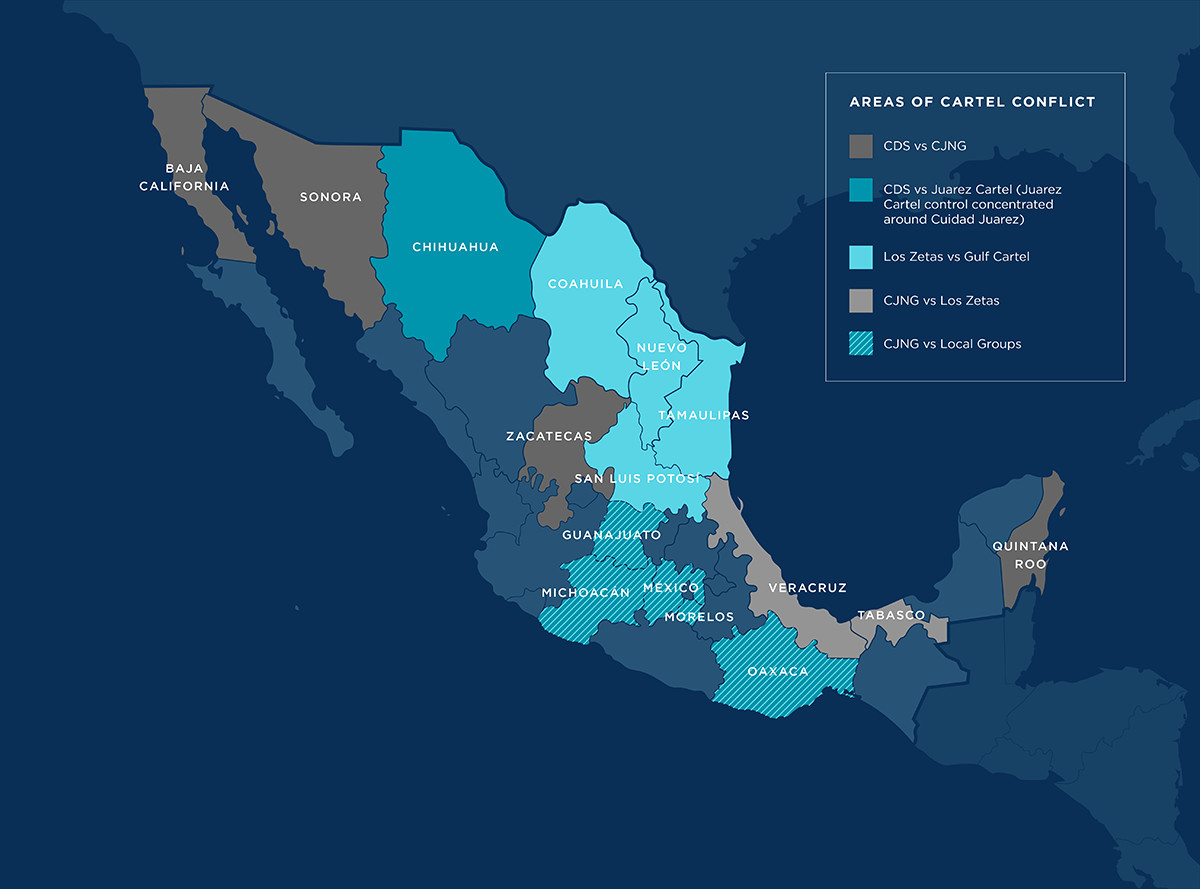The drug war in Mexico represents one of the most brutal conflicts globally, with cartel operations deeply embedded within various levels of Mexican society and its economy. Ongoing conflicts between cartels are the primary driver of violence throughout Mexico, extending even into tourist destinations like Cancun and Puerto Vallarta, which were once considered safer. This persistent inter-cartel violence poses significant disruptions to travel, business operations, and supply chains.
The Cartel Jalisco Nueva Generacion (CJNG), originating from Jalisco state, has risen as a dominant force in Mexico. This cartel exerts control or actively contests territories in states including Guanajuato, Michoacan, Baja California, Mexico State, Jalisco, Chihuahua, and Guerrero, among numerous other locations nationwide. The CJNG’s criminal activities are widespread, encompassing drug trafficking—particularly synthetics such as methamphetamine and fentanyl—kidnapping, extortion targeting sectors like avocado and lime farming, and illegal oil tapping in the Tierra Caliente region.
The Sinaloa Cartel (CDS), once the most powerful drug trafficking organization in Mexico, has faced increasing challenges to its dominance in recent years. The CJNG and internal fragmentation have significantly weakened its position, leading to intense infighting. The CDS is reportedly divided into several major factions: one under the leadership of Ismael “El Mayo” Zambada, formerly second-in-command to El Chapo; another led by Aurelio “El Guano” Guzmán Loera, El Chapo’s brother; and a third faction controlled by El Chapo’s sons, collectively known as “Los Chapitos.” The violent clashes between these factions and against the CJNG are major contributors to the high levels of violence across Mexico, especially in the western and northwestern parts of the country.
 Mexican Cartel Risk Map 2023: Visual representation of cartel influence and high-risk areas in Mexico, highlighting the pervasive drug war and its impact across the country.
Mexican Cartel Risk Map 2023: Visual representation of cartel influence and high-risk areas in Mexico, highlighting the pervasive drug war and its impact across the country.
The current criminal environment in Mexico is largely defined by the conflict between the Cartel Jalisco Nueva Generacion (CJNG) and the Sinaloa Cartel (CDS), although other significant transnational criminal organizations (TCOs) such as Los Zetas, the Gulf Cartel, and the Juarez Cartel also contribute to the pervasive violence.
The CJNG’s expansionist ambitions are a major factor in the surge of violence observed in recent years. The seven states previously mentioned have accounted for over half of all homicides nationally within the first six months of the year, highlighting the cartel’s broad and lethal reach. Nemesio “El Mencho” Oseguera Cervantes, the leader of the CJNG, is currently Mexico’s most wanted criminal, with a $10,000,000 bounty offered by the U.S. Drug Enforcement Agency (DEA) for his capture. Unlike Joaquin “El Chapo” Guzman of the CDS, El Mencho has successfully evaded capture by Mexican federal authorities. However, his son, “El Menchito,” was arrested, leading to a brazen display of power by the CJNG: they assassinated the federal judge overseeing his case who had approved his extradition to the U.S.
August 2022 witnessed a sharp escalation in cartel-related violence across numerous Mexican cities, including Tijuana, Ciudad Juarez, Guanajuato, and Guadalajara. On August 9th, violence erupted in Guadalajara and Guanajuato following the arrest of “El Doble R,” a high-ranking CJNG operative. Cartel members confronted security forces, setting fire to at least 25 OXXO convenience stores and numerous vehicles to impede the movement of security personnel. These events resulted in at least three fatalities, the destruction of 19 vehicles, and the arrest of 11 suspects.
On August 11th, in Ciudad Juárez, at least ten individuals were killed in attacks suspected to be carried out by cartel members targeting fast-food restaurants and convenience stores. These attacks were connected to deadly gang clashes earlier that day within the Ciudad Juárez prison (Cereso No. 3). The violence further spread overnight on August 12th to northern Baja California, affecting cities like Tijuana, Mexicali, Ensenada, and Rosarito. Carjacked vehicles, including buses and taxis, were set ablaze to create burning roadblocks, and multiple convenience stores were set on fire in an attempt to create chaos and divert emergency services. These blockades are believed to have been orchestrated by CJNG members in response to the arrest of “El Doble R” in Guadalajara. At least 17 individuals were arrested in connection with these incidents.
In response to the Tijuana violence, the Mexican Army deployed 350 soldiers and National Guard personnel to reinforce security across Baja California state. A similar deployment had occurred in the Quintana Roo area the previous year following increased cartel violence in tourist hotspots such as Cancun, Tulum, Playa del Carmen, and Cozumel.
Future arrests of high-ranking cartel figures are likely to trigger further violence. However, the Mexican government’s willingness to conduct such arrests may be diminishing after the events of August in Guadalajara, Tijuana, and other locations. This caution is further illustrated by the 2019 arrest of one of El Chapo’s sons, a leader within “Los Chapitos.” In response, the CDS mobilized a significant force, causing widespread chaos in Culiacan, the capital of Sinaloa. Security forces ultimately released him under orders from high-level government officials. This incident underscores not only the cartels’ capacity for violence but also the extent of their corruption and influence.
Key triggers that could escalate cartel violence include:
- Arrest of high-ranking cartel members
- Assassination of high-ranking cartel members
- Further fragmentation of TCOs into smaller groups
- Aggressive expansion into rival cartel territory
The pervasive influence of cartels in Mexico significantly impacts various sectors, including:
- Manufacturing
- Transport
- Pharmaceuticals
- Oil & Gas
- Retail
Analysis last updated September 2022
For businesses and individuals requiring security support in Mexico, Global Guardian offers services to assist with safety and risk management.